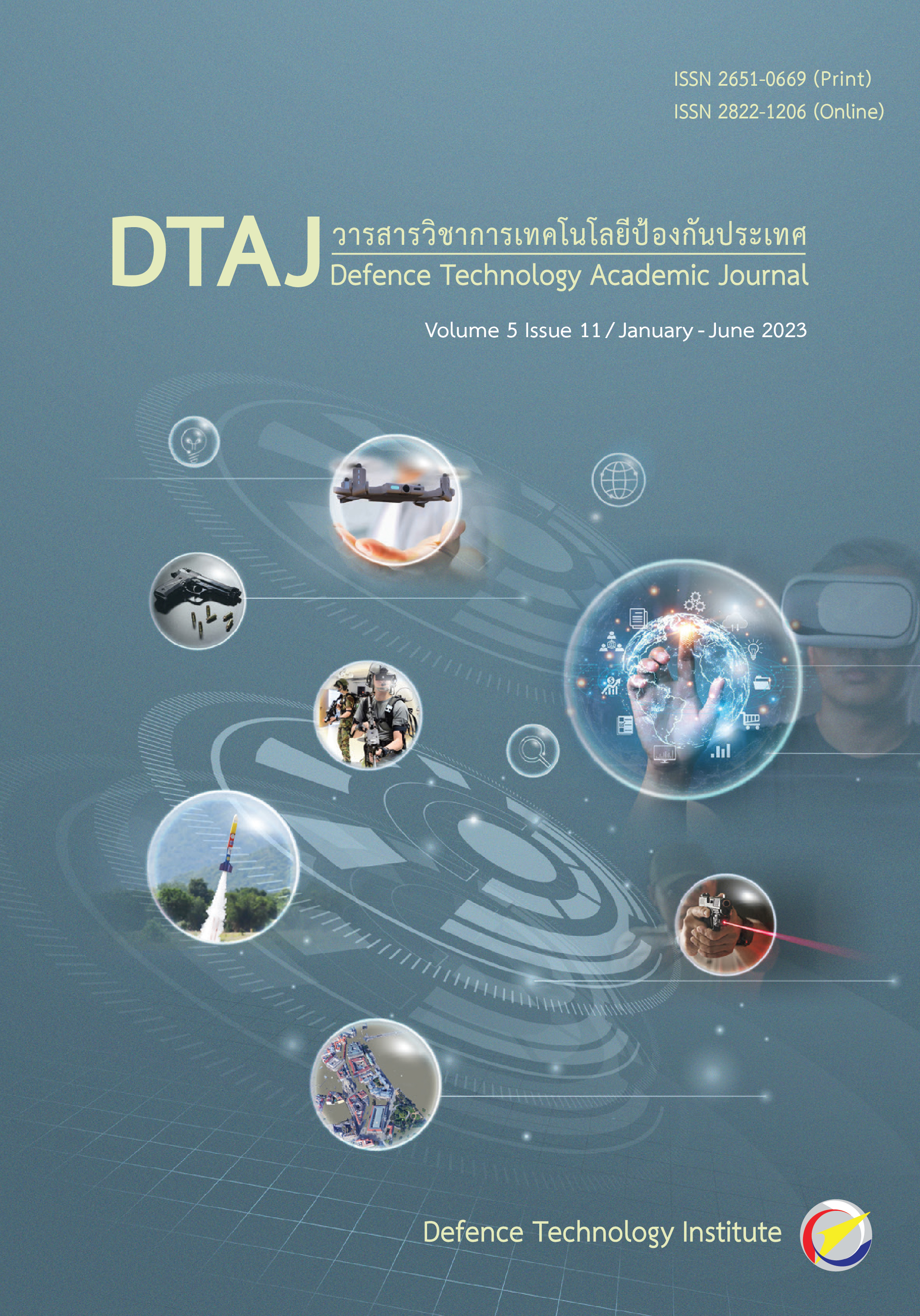การพัฒนาโครงข่ายประสาทเทียมในการทำนายการเคลื่อนที่ของแนววิถีจรวดประดิษฐ์
Main Article Content
บทคัดย่อ
การเคลื่อนที่ของแนววิถีจรวดประดิษฐ์เป็นการเคลื่อนที่แบบไม่เป็นเชิงเส้นซึ่งสามารถคำนวณได้หลากหลายวิธี เช่นการประยุกต์ใช้กฏของนิวตันมาสร้างสมการการเคลื่อนที่ หรือการใช้วิธีการของรุงเงและคุตตาอันดับที่ 4 โดยสมการทั้งหมดเป็นการปรับปรุงมาจากหลักการแบบจำลอง Modified Point Mass Trajectory Model (MPMTM) โดยจะทำการเปรียบเทียบคำตอบของผลเฉลย ซึ่งวิธีการเหล่านี้มีความยุ่งยากซับซ้อนในการคำนวณ และอาจเกิดความผิดพลาดในการคำนวณได้ ในบทความนี้จึงนำเสนอแบบจำลองโครงข่ายประสาทเทียมแบบแพร่ค่าย้อนกลับ (Back-propagation Neural Network) มาใช้ในการทำนายผลเฉลยของขีปนวิถีของจรวดที่เปลี่ยนแปลงจากผลของการเปลี่ยนแปลงตัวแปรนำเข้าของสมการขีปนวิถีเปลี่ยนแปลง (Rocket Trajectory in various input) ตามสภาพการใช้งานจริง ซึ่งตัวแปรนำเข้าป้อนเข้าจำนวน 5 ตัวแปร โดยใช้ค่าดรรชนีสมรรถนะเป็นตัวพิจารณาโครงข่ายประสาทเทียมที่ดีที่สุด จากการดำเนินการโครงข่ายประสาทเทียมในการหาเอกลักษณ์ที่มีประสิทธิภาพสุด มีค่าดรรชนีสมรรถนะอยู่ที่ 0.04 ซึ่งจะใช้โครงข่ายประสาทเทียมนี้เป็นตัวแทนการหาแนววิถีการเคลื่อนที่ของจรวดประดิษฐ์แทนการคำนวณสมการที่ยุ่งยาก ซึ่งทำให้ง่ายและรวดเร็วในการใช้งานจริงมากยิ่งขึ้น
Downloads
Article Details

This work is licensed under a Creative Commons Attribution-NonCommercial-NoDerivatives 4.0 International License.
Journal of TCI is licensed under a Creative Commons Attribution-NonCommercial-NoDerivatives 4.0 International (CC BY-NC-ND 4.0) licence, unless otherwise stated. Please read our Policies page for more information...
References
A. Ko, K. Chan, D.-J. Sheen, C.-H. Lee, Y. Park, and S. W. Park, “Prediction and Analysis of the Aerodynamic Characteristics of a Spinning Projectile Based on Computational Fluid Dynamics,” Int. J. Aerosp. Eng., vol. 2020, pp. 1-12, 2020.
S. K. Gupta, S. Saxena, A. Singhal, and A. K. Ghosh, “Trajectory Correction Flight Control System using Pulsejet on an Artillery Rocket,” Def. Sci. J., vol. 58, no. 1, pp. 15-33, 2008.
Q.-B. Zhou, X.-T. Rui, G.-P. Wang, and J.-S. Zhang, “An Efficient and Modular Modeling for Launch Dynamics of Tubed Rockets on a Moving Launcher,” Def. Technol., vol. 17, No. 6, pp. 2011 - 2026, 2021.
L. An, L. Wang, N. Liu, J. Fu, and Y. Zhong, “A Novel Method for Estimating Pitch and Yaw of Rotating Projectiles Based on Dynamic Constraints,” Sensors, vol. 19, no. 23, p. 5096, 2019.
N. Nattapob, “Neural Network and Artificial Intelligent,” M.S. thesis, Fac. Eng., Bangkok Univ., Bangkok, Thailand, 2007. (in Thai)
I. Gandarilla, J. Montoya-Cháirez, V. Santibáñez, C. Aguilar-Avelar, and J. Moreno-Valenzuela, “Trajectory Tracking Control of a Self-balancing Robot via Adaptive Neural Networks,” Eng. Sci. Technol., Int. J., vol. 35, p. 101259, 2022.
I. Lopez-Sanchez, J. Moyrón, and J. Moreno-Valenzuela, “Adaptive Neural Network-based Trajectory Tracking Outer Loop Control for a Quadrotor,” Aerosp. Sci. Technol., vol. 129, p. 107847, 2022.
S. Shen and J. Xu, “Adaptive Neural Network-based Active Disturbance Rejection Flight Control of an Unmanned Helicopter,” Aerosp. Sci. Technol., vol. 119, p. 107062, 2021.
S. Choi and Y. J. Kim, “Artificial Neural Network Models for Airport Capacity Prediction,” J. Air Transp. Manag., vol. 97, p. 102146, 2021.
K. Balla, R. Sevilla, O. Hassan, and K. Morgan, “An Application of Neural Networks to the Prediction of Aerodynamic Coefficients of Aerofoils and Wings,” Appl. Math. Model., vol. 96, no. 10, pp. 456 - 479, 2021.
E. Nawapak, “Documents for Artificial Neural Networks Subject,” M.S. thesis, Fac. Eng., Khonkhan Univ., Khonkhan, Thailand, 2003. (in Thai)
A. Puitrakul. “An Introduction (?) to Deep Learning.” ARNONDORA.in.th. https:// arnondora.in.th/an-introduction-to-deep -learning/ (accessed July. 4, 2022) (in Thai)
H. T. Nguyen, N. R. , C. L. Walker, and E. A. Walker, A First Course in Fuzzy and Neural Control. Boca Raton, FL, USA: Chapman&Hall/CRC, 2002.

